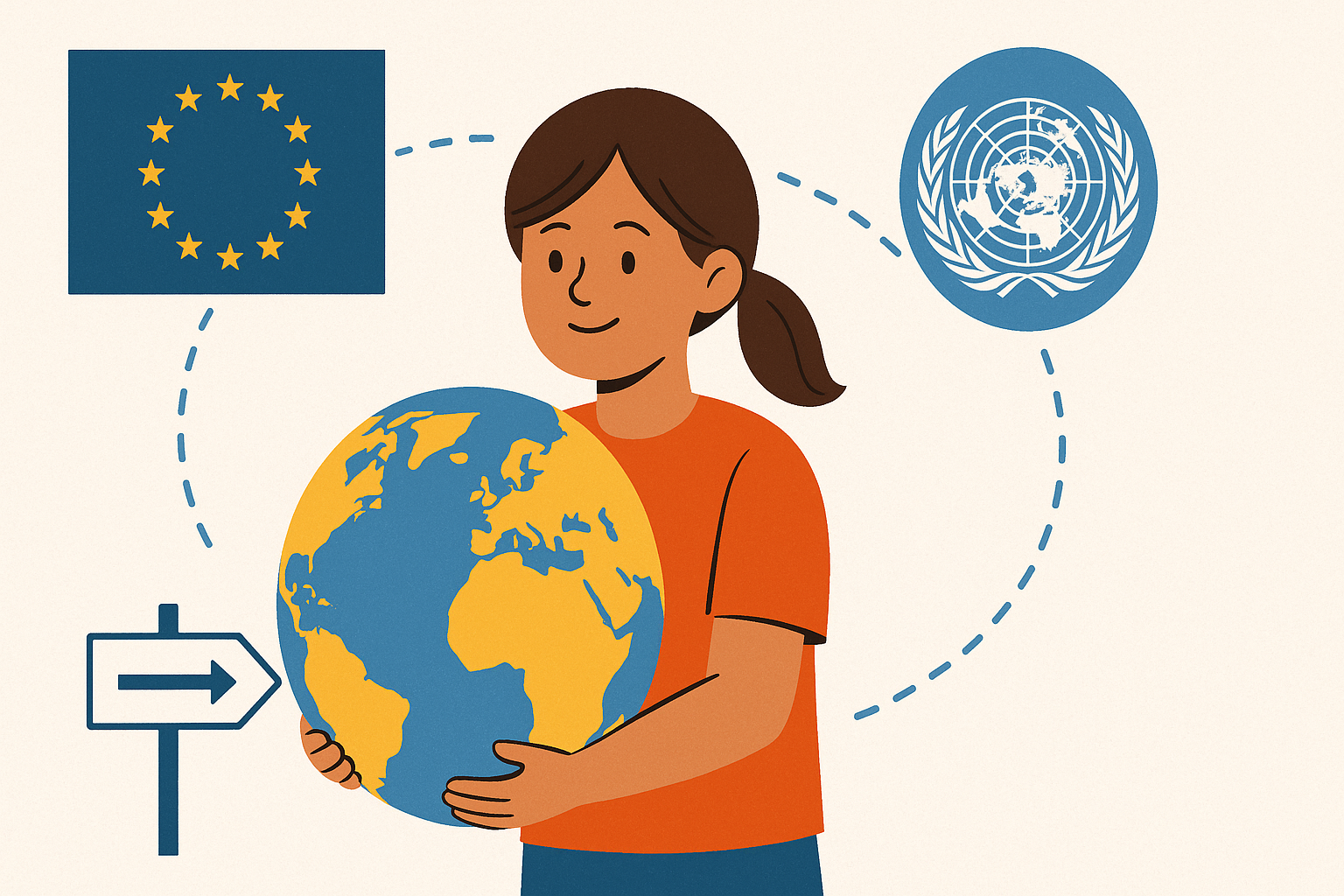Author: Vaska Bojadji, Child Rights expert
The commitment to children’s rights is not just a legal formality; it’s a reflection of a nation’s dedication to nurturing, protecting, and empowering its youngest citizens. Various international human rights mechanisms are in place to monitor how well a country upholds these rights and to guide its progress. One of these is the Universal Periodic Review (UPR), a unique UN-led peer-review process where all countries are periodically assessed on their human rights records and receive recommendations—many of which focus on children’s rights.
At the same time, advancing children’s rights is a critical component of the EU accession process. Candidate countries are required to undertake substantial reforms to align with the EU acquis. Each year, the European Commission’s progress reports offer key recommendations aimed at ensuring that candidate countries implement reforms that reflect EU values, standards, and policies.
This blog explores key areas where the Macedonian children’s rights framework can be strengthened in line with the latest UPR recommendations and the European Commission’s Progress Report. It delves into legal reforms, policy strategies, and the pivotal role of institutions in safeguarding and promoting children’s rights.
Strengthening Governance: Addressing Policy and Coordination Gaps in Children’s Rights
National child rights strategies are essential policy instruments that provide a coherent framework for advancing children’s rights. These strategies are designed as cross-sectoral roadmaps that articulate a shared vision among key stakeholders—including government institutions, agencies, and civil society—toward measurable goals that promote the wellbeing of every child. At their core, such strategies foster coordinated government action and sustained progress by aligning policies and interventions across sectors.
The country previously had such a framework in place—the National Action Plan for the Rights of the Child (NAPRC), adopted in 2005. However, this strategy expired in 2015 and was never renewed, creating a prolonged vacuum in national child rights governance. While current efforts are focused on adopting a new strategic document, the absence of an overarching framework for nearly a decade has undermined coherent policy implementation and slowed progress.
This policy gap has been compounded by the absence of a functioning coordination mechanism. Since the dissolution of the National Commission for the Rights of the Child in 2017, there has been no dedicated governmental body responsible for overseeing the implementation and monitoring of child rights across sectors. International best practices, as well as recommendations from European Commission’s Progress Report—highlight the crucial role such bodies play in ensuring accountability, fostering inter-ministerial collaboration, and securing sustained investment in child rights.
To avoid repeating past shortcomings, the establishment of a new national strategy and coordination body must be informed by previous lessons. The earlier action plan lacked proper monitoring and reporting mechanisms, while the now-defunct National Commission struggled with effectiveness and visibility. Moving forward, a re-established coordination body must be adequately resourced, institutionally anchored, and equipped with a clear mandate to track progress, report transparently, and meaningfully engage civil society and children themselves.
The road to stronger child rights governance lies not just in adopting policies, but in ensuring they are implemented, monitored, and continually improved upon. Without such strategic and institutional foundations, progress risks being fragmented, unsustainable, and ultimately insufficient to meet the needs of children across the country.
Bridging the Legal Gap: Unratified Treaties
A strong legal framework is the backbone of any effective child rights system—but legal progress doesn’t end with domestic reform. It also means embracing key international standards that offer children greater protection and access to justice. While steps have been taken, several important treaties still await full ratification.
Of particular significance is the Optional Protocol to the Convention on the Rights of the Child on a Communications Procedure (OPIC). This instrument, signed back in 2012, offers a powerful mechanism: it allows children, or their representatives, to bring complaints about rights violations directly to the UN Committee on the Rights of the Child—but only if they’ve exhausted all remedies at home. In essence, OPIC gives children a voice on the international stage when national systems fail to listen. Yet more than a decade later, the country has not ratified it, leaving a vital accountability gap wide open.
The importance of ratifying OPIC has been underscored in both the Universal Periodic Review and recommendations by the UN Committee itself. Without this channel, children facing violations—whether in education, protection, or justice—have limited recourse beyond domestic systems that may not always work in their favor.
Other international treaties also remain in limbo. The 1996 Hague Convention on Child Protection and the 2007 Hague Convention on Child Support, signed in 2019, are yet to be ratified—despite offering crucial tools for cross-border cooperation on custody, guardianship, and maintenance. Similarly, the International Convention on the Protection of the Rights of All Migrant Workers and Members of Their Families, and the Convention on Enforced Disappearances, remain unsigned or unratified, leaving important gaps in the legal safety net for children and families on the move or at risk.
If the country is to truly align with its global children’s human rights commitments, closing these legal gaps must be seen as a priority.
Strengthening Oversight: The Role of Independent Mechanisms
Independent monitoring institutions such as the Ombudsperson and the Commission for the Prevention and Protection against Discrimination (the Commission) play an essential role in protecting and promoting the rights of children. Their presence reflects a broader commitment to accountability, fairness, and the rule of law. However, persistent challenges—including limited human and financial resources—continue to constrain their ability to fulfill their mandates effectively, particularly in areas concerning children.
The Ombudsperson’s Department for the Protection of the Rights of Children and Persons with Disabilities handles individual complaints, conducts thematic research, and issues recommendations aimed at addressing systemic challenges. Yet, with only a small team—of whom several focus primarily on disability rights—the Department faces difficulty in fully addressing the breadth and complexity of issues affecting children. These limitations have been noted by the Committee on the Rights of the Child, which has consistently called for increased resourcing and institutional strengthening.
Delays in the parliamentary follow-up process also pose a challenge. Although the Ombudsperson submits its Annual Report in a timely manner, the corresponding measures are often adopted late in the year, leaving little space for timely government response and follow-through. The Office has acknowledged the need to align more closely with the Paris Principles and has set a goal to achieve “A status” by 2027. Legislative amendments currently in parliamentary procedure aim to support this goal and strengthen institutional independence.
The Commission, re-established under a strengthened mandate in 2020, is increasingly active in addressing discrimination involving children. It can receive complaints directly from children or on their behalf and has initiated ex officio cases on important child protection issues, such as educational support and school segregation. However, its ability to carry out its responsibilities is impacted by a significant number of unfilled staff positions. According to its 2025 Annual Report, these vacancies—due to delayed approvals—seriously affect the Commission’s operational capacity.
Although the Commission collects some data on the age of complainants, it currently lacks a clear system to track cases that specifically relate to children. Strengthening this aspect of its work could help better identify patterns of discrimination and inform more targeted responses.
Both the Universal Periodic Review and the European Commission’s Progress Report highlight the need to ensure that these institutions have sufficient independence, staff, and resources to carry out their mandates effectively. Ensuring that these bodies are empowered and fully functional is a key step toward making rights real for all children—not just in principle, but in everyday life.
Advancing Education Reform: Inclusion, Equity, and Remaining Gaps
Recent legislative reforms have aimed to improve access, equity, and quality across primary, secondary, and vocational education. While these reforms mark a step forward, they also raise important concerns about implementation, inclusion, and legal coherence—especially for children from marginalized groups.
Primary Education Reforms
Amendments to the Law on Primary Education in late 2024 aimed to address long-standing issues, including compliance with the Elmazova and Others v. North Macedonia judgment, which confirmed segregation of Roma children in primary schools. New rules reinforce catchment-based enrollment but include exceptions, such as transfers based on language or psychosocial justifications. The Ombudsperson has highlighted the lack of clarity and follow-up on desegregation measures.
The same law introduced changes affecting children with disabilities, allowing parents to choose between mainstream schools and schools with resource centres — specialized institutions that were previously expected to stop enrolling new students and transition into support hubs for inclusive education within mainstream schools. Civil society groups warn it may lead to the re-segregation of children with complex needs, especially given the limited capacity and readiness of many schools to provide inclusive support. Inclusive education continues to face serious implementation barriers: lack of trained staff, inadequate teaching tools, and inconsistent access to educational assistants remain widespread.
The amendments to the Law on Primary Education also removed explicit references to “gender,” “gender identity,” and “sexual orientation” as protected grounds. While a general non-discrimination clause remains, this change has raised concerns about legal clarity. Commission for the Prevention and Protection against Discrimination and civil society actors have stressed the need for alignment with broader anti-discrimination laws to ensure consistent protection for all students.
Secondary Education
Notably, recent amendments to the Law on Secondary Education guarantee access for all students, including those with disabilities, and institutionalize the role of state-funded educational assistants—replacing temporary programme-based arrangements. The reforms also promote student participation in school governance, establish roles like career counselors, and introduce a new framework for standardized final exams. These steps aim to make secondary education more inclusive, participatory, and aligned with future skills needs.
Vocational Education
Adopted in late 2024, the new Law on Vocational Education and Training brings the VET system closer to international standards. It recognizes dual education—combining classroom learning with real work experience—and establishes regional VET centres as hubs for lifelong learning and skills development. These centres are designed to work closely with local employers and authorities, improving responsiveness to labor market demands. While promising, these reforms must be backed by resources and coordinated efforts to ensure equal access for all learners.
What Still Needs to Be Done?
Both the UPR recommendations and the European Commission’s Progress Report stress the need to move beyond laws and ensure implementation: this includes improving access to quality education for children with disabilities and Roma children, and strengthening teacher training through sustained investment in their professional development.
While legislative updates lay the foundation, meaningful progress hinges on translating commitments into practice—through adequate funding, institutional accountability, and active engagement with communities to ensure that no child is left behind.
Vulnerable Children in Focus
Efforts to protect children’s rights must place particular focus on those most at risk. Both the UPR recommendations and the European Commission’s Progress Report call for targeted action to support children from marginalized groups, including Roma children, children with disabilities, stateless children, and child victims of trafficking.
Birth Registration and Legal Identity
Ensuring every child’s legal identity is a fundamental step toward safeguarding their rights. For years, the country lacked a sustainable mechanism for registering children whose parents have no personal identification documents. The 2020 Law on Unregistered Persons in the Birth Registry attempted to address this issue, alongside the 2023 amendments to the Law on Civil Registry, however challenges persist with hundreds of cases still pending due to administrative delays, lack of documentation, or parental non-appearance. Full enforcement of the law and stronger coordination between institutions will be crucial to ensure that no child remains invisible.
Combating Child Trafficking
The country has made commendable progress in establishing legal and institutional frameworks to combat child trafficking. The Action Plan for Combating Trafficking of Children (2021–2025) outlines a comprehensive strategy supported by inter-institutional cooperation and civil society engagement. A dedicated Sub-group on Child Trafficking leads operational planning and reporting. However, stronger alignment with the Lanzarote Convention and EU law is needed. Ongoing concerns include insufficient specialized accommodation for child victims, inconsistent access to legal aid, and under-resourced social services. Continued attention to these gaps will be vital for ensuring that protective systems work in practice.
Justice for Children
The 2024 Law on Justice for Children marks a major step forward, introducing a restorative and child-centered approach. However, implementation challenges remain, particularly in ensuring access to formal education for children in correctional facilities. Addressing these gaps is vital to building a truly rehabilitative and rights-based juvenile justice system.
Ending Violence Against Children: Strategy, Gaps, and the Way Forward
Efforts to protect children from violence have gained policy traction in recent years, but progress on the ground remains uneven. Despite an existing policy foundation, implementation remains a persistent challenge. The National Strategy to Prevent and Protect Children from Violence (2020–2025) set out framework to build a coordinated, cross-sectoral response rooted in zero tolerance for violence. However, with no public reports on its implementation, no updated Action Plan since 2022, and unclear functioning of the national coordinating body, the system risks stagnation without renewed attention and investment. The UPR and the European Commission have called for stronger institutional support, adequate funding, and better data to ensure that children—particularly those who are vulnerable—receive timely and effective protection.
One of the harmful practices affecting children is child marriage. Although legally prohibited, exceptions in the Family Law still allow marriage under 18 with court approval. The Committee on the Rights of the Child and UPR recommendations urge the removal of all such exceptions. Roma girls are especially affected, with early marriage rates nearly six times higher than in the general population. Yet, responses remain limited. Without clear protocols, community engagement, or targeted prevention efforts, legal protections alone are not enough to disrupt entrenched harmful practices.
CONCLUSION
Advancing children’s rights is not a one-off reform—it is a continuous process of aligning systems with the lived realities of children. The UPR and EU accession processes provide valuable guidance on where change is most needed.
Future reforms should not only respond to international recommendations, but also serve as a catalyst for building a stronger, more inclusive system that delivers for all children—every day, in every community. This means prioritizing implementation, closing coordination gaps, investing in institutions, and amplifying the voices of children themselves, as well as those who care for and work with them.
The blog was prepared as part of the project “Joint Action for Human Rights” implemented by the European Policy Institute, financed by the European Union. The contents of this blog do not reflect the official opinions and positions of the European Union. Responsibility for the information and views expressed in this blog lies entirely with the European Policy Institute (EPI) – Skopje and the speakers.






